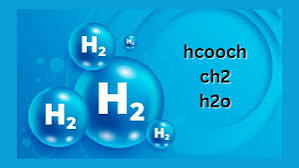Table of Contents
- Introduction to the Chemical Equation
- Breaking Down the Components: HCOOH, CH₂, and H₂O
- Possible Chemical Interpretations
- The Role of Formic Acid in Reactions
- Chemistry Behind CH₂ and Its Reactivity
- Conclusion
- FAQs
Introduction to the Chemical Equation
At first glance, the chemical equation hcooch ch2 h2o may seem abstract, but it presents an interesting scenario in organic chemistry. This equation suggests a potential reaction between formic acid (HCOOH) and a CH₂ fragment, resulting in the formation of H₂O (water). While this exact reaction isn’t commonly seen in basic textbooks, it can still be a valuable learning tool in understanding how different chemical species interact.
In this article, we’ll break down the components and discuss possible reactions and interpretations, helping you better understand how this equation could theoretically play out.
Breaking Down the Components: HCOOH, CH₂, and H₂O
1. HCOOH (Formic Acid)
Formic acid is the simplest carboxylic acid, with the molecular formula HCOOH. It has one carbon, two hydrogens, and two oxygens. It’s commonly found in nature, particularly in the venom of ants, which is where its name originates (formica means “ant” in Latin). Formic acid is widely used in industrial processes, such as leather production, as well as in some preservation methods.
- Chemical properties of formic acid:
- It has a pungent odor.
- It’s a weak acid but has significant reactivity, particularly in esterification reactions.
2. CH₂ (Methene or Carbene)
CH₂ is often considered as a carbene, a species that consists of a carbon atom bonded to two hydrogen atoms with a pair of unshared electrons. Carbenes are highly reactive and do not exist freely for long periods under normal conditions. They are intermediates in many organic reactions, particularly in addition reactions to alkenes.
- Key properties:
- Very reactive
- Often short-lived and reactive in nature
3. H₂O (Water)
The product of the reaction is water (H₂O), which is a simple molecule that is essential for life and plays a role in countless chemical processes, including acting as a solvent in many biological and chemical reactions. In this context, the formation of water suggests a condensation or elimination reaction.
Possible Chemical Interpretations
While the reaction HCOOH + CH₂ → H₂O isn’t commonly found in standard organic chemistry, we can still analyze it theoretically. One possible interpretation is that the CH₂ fragment, likely a reactive carbene, interacts with formic acid to eliminate a molecule of water. This could suggest a dehydration or condensation reaction, where the CH₂ group joins with the formic acid to form a new bond while releasing water as a by-product.
In another context, this reaction might represent a decarboxylation or a similar reaction in which formic acid undergoes a transformation, with CH₂ playing the role of an intermediate or a reactive species in the process.
The Role of Formic Acid in Reactions
Formic acid is a versatile molecule in organic chemistry, involved in many reactions such as esterification, reduction, and decarboxylation. Its simplicity allows it to participate in both simple and complex reactions. In some cases, it can act as a reducing agent or undergo transformations that lead to the formation of important intermediates in synthetic chemistry.
For instance, formic acid is known to release carbon dioxide (CO₂) when it undergoes decarboxylation, and it’s often involved in reactions where its carboxyl group (-COOH) plays a key role in bond formation or breakage.
Chemistry Behind CH₂ and Its Reactivity
CH₂, or methene, is an example of a carbene. Carbenes are extremely reactive intermediates that can bond to various molecules, often causing significant rearrangements or additions in organic compounds. hcooch ch2 h2o Because CH₂ contains a carbon atom with two single bonds and two unpaired electrons, it is highly reactive and can form bonds with a variety of atoms or molecules.
Due to its reactivity, CH₂ can be involved in reactions such as cycloadditions, insertion reactions, and other transformations that result in the creation of new compounds. If CH₂ interacts with formic acid, it could lead to the formation of a new compound, with the elimination of H₂O as a product.
Conclusion
The reaction hcooch ch2 h2o offers a thought-provoking scenario in the realm of organic chemistry. While not a typical reaction in mainstream chemistry, it demonstrates the complexity and creativity inherent in chemical reactions. By considering the reactivity of formic acid and the highly reactive carbene CH₂, we can imagine various transformations that could lead to the release of water as a by-product.
Ultimately, chemistry is a field full of surprises, and even unusual reactions like this can provide valuable insight into the principles of organic chemistry and molecular interaction.
FAQs
1. What is formic acid used for in industry?
Formic acid is used in leather production, as a preservative in food, and in various chemical processes such as esterification and as a reducing agent in organic synthesis.
2. Is CH₂ stable?
No, CH₂ is a highly reactive species and is generally unstable in its free form. It exists as an intermediate in many organic reactions.
3. Can CH₂ react with other compounds besides formic acid?
Yes, CH₂ is highly reactive and can bond with a variety of compounds, including alkenes and other organic molecules, to form new compounds.
4. What other reactions involve formic acid?
Formic acid is involved in several reactions, including esterification, reduction, decarboxylation, and as a component in biodiesel production.
**5. Why is *CH₂* considered a carbene?**
CH₂ is considered a carbene because it contains a carbon atom with two single bonds and a pair of unshared electrons, making it highly reactive and able to form new bonds with other molecules.
Through this exploration, we can appreciate the fascinating possibilities within the realm of organic chemistry, even from seemingly simple equations.



